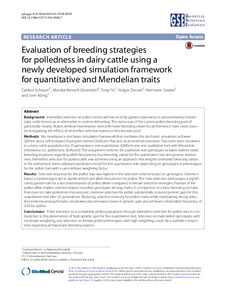Evaluation of breeding strategies for polledness in dairy cattle using a newly developed simulation framework for quantitative and Mendelian traits
| dc.date.accessioned | 2016-11-09T12:22:59Z | |
| dc.date.available | 2016-11-09T12:22:59Z | |
| dc.date.issued | 2016-06-29 | |
| dc.identifier.issn | 1297-9686 | |
| dc.identifier.uri | urn:nbn:de:hebis:34-2016110951348 | |
| dc.identifier.uri | http://hdl.handle.net/123456789/2016110951348 | |
| dc.description.sponsorship | Gefördert durch den Publikationsfonds der Universität Kassel | |
| dc.language.iso | eng | |
| dc.rights | Urheberrechtlich geschützt | |
| dc.rights.uri | https://rightsstatements.org/page/InC/1.0/ | |
| dc.subject.ddc | 630 | |
| dc.title | Evaluation of breeding strategies for polledness in dairy cattle using a newly developed simulation framework for quantitative and Mendelian traits | eng |
| dc.type | Aufsatz | |
| dcterms.abstract | Background: Intensified selection of polled individuals has recently gained importance in predominantly horned dairy cattle breeds as an alternative to routine dehorning. The status quo of the current polled breeding pool of genetically-closely related artificial insemination sires with lower breeding values for performance traits raises questions regarding the effects of intensified selection based on this founder pool. Methods: We developed a stochastic simulation framework that combines the stochastic simulation software QMSim and a self-designed R program named QUALsim that acts as an external extension. Two traits were simulated in a dairy cattle population for 25 generations: one quantitative (QMSim) and one qualitative trait with Mendelian inheritance (i.e. polledness, QUALsim). The assignment scheme for qualitative trait genotypes initiated realistic initial breeding situations regarding allele frequencies, true breeding values for the quantitative trait and genetic relatedness. Intensified selection for polled cattle was achieved using an approach that weights estimated breeding values in the animal best linear unbiased prediction model for the quantitative trait depending on genotypes or phenotypes for the polled trait with a user-defined weighting factor. Results: Selection response for the polled trait was highest in the selection scheme based on genotypes. Selection based on phenotypes led to significantly lower allele frequencies for polled. The male selection path played a significantly greater role for a fast dissemination of polled alleles compared to female selection strategies. Fixation of the polled allele implies selection based on polled genotypes among males. In comparison to a base breeding scenario that does not take polledness into account, intensive selection for polled substantially reduced genetic gain for this quantitative trait after 25 generations. Reducing selection intensity for polled males while maintaining strong selection intensity among females, simultaneously decreased losses in genetic gain and achieved a final allele frequency of 0.93 for polled. Conclusions: A fast transition to a completely polled population through intensified selection for polled was in contradiction to the preservation of high genetic gain for the quantitative trait. Selection on male polled genotypes with moderate weighting, and selection on female polled phenotypes with high weighting, could be a suitable compromise regarding all important breeding aspects. | eng |
| dcterms.accessRights | open access | |
| dcterms.bibliographicCitation | In: Genetics Selection Evolution. - London : BioMed Central. - (2016) 48:50 | |
| dcterms.creator | Scheper, Carsten | |
| dcterms.creator | Wensch-Dorendorf, Monika | |
| dcterms.creator | Yin, Tong | |
| dcterms.creator | Dressel, Holger | |
| dcterms.creator | Swalve, Herrmann | |
| dcterms.creator | König, Sven | |
| dc.relation.doi | doi:10.1186/s12711-016-0228-7 |
Dateien zu dieser Ressource
Das Dokument erscheint in:
-
Publikationen [2]
-
Artikel [1195]

